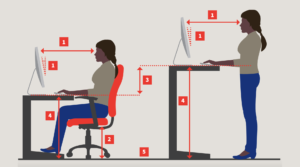Back Pain: A Common Enemy We Can Understand Better
Ever felt that nagging ache in your lower back after a long day of work, or maybe a sudden sharp pain that makes you wince while lifting groceries? Back pain, a common enemy we all face at some point, affects millions of people in India and around the world. It can be a real drag, showing up in various forms, from a dull ache that lingers to a sharp, shooting pain that takes your breath away. On top of the discomfort, it can be confusing with so many different types and symptoms.

But hold on tight! This blog is here to be your helping hand on the journey to understanding back pain. We’ll break things down in a way that’s easy to understand, exploring:
- The Different Faces of Back Pain: We’ll delve into the diverse experiences you might have, from a mild ache to a sharp, sudden pain. Did you know that even the way you sit, stand, or lift things can play a role in back pain? We’ll explore these connections too!
- Understanding the Signals Your Body Sends: Your body has a way of communicating with you, and sometimes back pain is its way of saying something isn’t quite right. We’ll discuss the different ways your body might be “talking” to you through back pain, helping you identify what’s going on.
- How Common is Back Pain? You might be surprised to know just how widespread back pain actually is. We’ll explore statistics and research, using information from trusted sources like the National Institute of Neurological Disorders and Stroke (NINDS) to understand how common it is both globally and specifically in India.
Remember, this information is for educational purposes only and should never replace professional medical advice. If you’re concerned about your back pain, it’s always best to consult with a doctor or other qualified healthcare professional. So, whether you’re currently dealing with back pain or simply curious to learn more, keep reading! We’ll help you understand your back pain and hopefully feel more empowered to manage it effectively.
Types of back pain:
Back pain can manifest in diverse ways, from dull aches to stabbing pains. Understanding the specific characteristics helps identify potential causes and solutions. Here are some common types of back pain:
Dull Pain
A persistent dull, aching pain is often associated with muscle tension or joint stiffness. Poor posture strains the back muscles leading to aching discomfort. Arthritis in the spine also typically causes dull pain that worsens with activity. Applying heat, gentle stretches, and massages can provide relief.
Sharp Pain
A sudden, piercing pain may indicate issues with the vertebrae, discs, or nerve roots. A slipped disc that presses on a nerve can cause sharp lower back pain. Spinal stenosis, or narrowing of the spinal canal, also produces sharp pains that radiate down the legs. Resting the back and avoiding reinjury are key to recovery.
Throbbing Pain
An intense throbbing sensation usually signals muscle spasms or inflammation. The back muscles can spasm in response to strain, irritation of a nerve, or as a postural reaction. Sitting for long periods in unhealthy positions commonly causes throbbing back pain. Anti-inflammatory medication and hot compresses help ease this type of pain.
Stabbing Pain
An abrupt stabbing pain suggests nerve compression. Sciatica, a sharp pain radiating from the lower back into the buttocks and legs, frequently results from a herniated disc impinging the sciatic nerve. Stabbing pain also occurs with spinal injuries like fractures. Doctors may recommend imaging tests and prescribe pain medication or nerve block injections.
Referred Pain
Sometimes pain feels like it originates from one area but is actually caused by a problem elsewhere. Referred lower back pain can signal an issue higher up like spinal arthritis or a kidney infection. Upper back pain can also reflect gastric reflux, pancreatitis, or other internal organ dysfunction. Identifying and treating the root cause provides relief.
In summary, back pain has many distinct qualities based on the underlying injury or condition according to the American Physical Therapy Association. Being aware of different types helps determine appropriate treatments, which may range from home remedies to medical interventions. Consult a doctor if severe or persistent back pain limits daily activities.
Unraveling the Mystery: Common Causes of Back Pain
Back pain can be an extremely disruptive and frustrating condition. Understanding the root causes is key to finding the right treatment and prevention. Back pain has many potential underlying causes, ranging from mild muscle strains to more serious conditions like herniated discs or sciatica.
One of the most common sources of back pain is muscular strain, especially in the lower back area. Lifting heavy objects, sudden movements like twisting, or even just poor posture over time can overwork the back muscles and ligaments, causing that nagging ache we’re all too familiar with. Muscle relaxers, gentle stretches, heat, and rest can often help alleviate this type of mechanical back pain. Proper lifting technique and core strengthening exercises are useful for prevention.
Herniated or ruptured discs often lead to acute back pain. Discs act as cushions between the vertebrae, the individual bones of the spine. Their gel-like centers can bulge or leak out through tears in the outer lining, pressing on nerves and causing pain. This pain typically radiates into the buttocks and legs. Herniated discs can arise from injury, repetitive strain, or aging spine changes. Treatment usually involves pain medication and physical therapy, along with possible steroid injections or surgery for severe cases.
Sciatica is characterized by radiating pain from the lower back down through the hips and legs, following the path of the sciatic nerve. In addition to the shooting, burning pain, it may also cause tingling, numbness or difficulty moving the leg. A herniated disc pressing on the nerve root is the most common cause of sciatica. Other sources could include a pelvic tumor, tight muscles compressing the nerve, spinal stenosis, or spondylolisthesis (slippage of one vertebra on another). Relieving pressure on the nerve through muscular release techniques, medication, or sometimes surgery can help manage the discomfort of sciatica.
Poor posture puts constant strain on the spine, neck, and back muscles, setting the stage for chronic pain. Slumping at a desk all day forces the neck and upper back into an unnatural curved position. Extended sitting can flatten the lower back’s natural arch, rotating the pelvis backward. This overstretches the back muscles and compresses the discs. Making sure to take frequent breaks, using proper chair and desk ergonomics, and doing regular posture exercises can help. Devices like posture trainers also provide helpful biofeedback.
As this overview shows, back pain can stem from a variety of causes. Staying aware of your posture, maintaining core strength, practicing proper lifting mechanics, and managing conditions can help fend off many back woes. When pain does strike, consulting a health professional can ensure proper diagnosis and treatment. With some care, most back pain is manageable. Understanding where it comes from is the first step.
For more details on these common causes of back pain, you can check out these helpful resources:
These websites offer credible information from reputable medical institutions.
When to Seek Help: Red Flags in Back Pain
While most back pain improves with some rest and basic home treatment, certain red flags warrant prompt medical attention. Being aware of signs that indicate a potentially serious problem requiring a doctor’s care is crucial. Catching these issues early greatly improves outcomes.
According to the American Academy of Family Physicians (AAFP), you should consult a physician rapidly if your back pain is accompanied by certain symptoms. These red flags include: loss of bladder or bowel control; sudden weakness or numbness in the legs; fever along with the pain; unexplained weight loss; and pain following a significant trauma like a vehicle accident or fall .
Intractable pain that progressively worsens, especially at night, could signal an infection or cancer. Being unable to bear any weight on your legs may indicate a nerve compression issue requiring prompt evaluation. Back pain that persists for more than a month without improvement also warrants medical investigation to identify the underlying cause.
Additionally, those with a history of cancer, steroid use, or drug abuse should have their back pain assessed by a doctor even without other symptoms. The elderly and immunocompromised should also seek attention quickly due to higher risks.
While most back pain is non-specific and mechanical in nature, approximateltly 1% have an underlying medical condition requiring specific treatment. Catching serious issues early makes a big difference in being able to stop irreversible damage. Even if the chance of a major problem is low, it is always better to err on the side of caution and have back pain with red flags thoroughly evaluated.
Do not hesitate to make an appointment with your family physician, a back pain specialist, or a physiotherapist if your symptoms concern you at all. Most causes of back pain are highly treatable, especially when addressed promptly before they can worsen. Getting professional help for alarming back pain provides peace of mind and ensures you receive proper diagnosis and care.
Taming the Back Ache: Simple Tips for a Healthier You
Back pain can be a real pain (pun intended!), stopping you from doing the things you love. It can feel like a stubborn friend who just won’t leave, making it hard to concentrate at work or even enjoy a simple walk in the park. But fear not, there are ways to fight back and get your life back on track!
Here are a few simple tips that have helped me, and might just help you too:
1. Stretch it out like a rubber band: Remember those childhood games where you’d stretch a rubber band until it almost snapped? We don’t want that for our muscles! Gentle stretches can help loosen up tight muscles and improve flexibility, ultimately reducing back pain. Even just a few minutes each day doing some basic stretches can make a big difference. In India, many people practice yoga, which is a fantastic way to combine stretching with mindfulness and improve overall well-being.
2. Move it, move it!: Sitting all day at a desk is the enemy of a happy back. Staying active is crucial for back health, as regular exercise strengthens the muscles that support your spine and keeps your posture in check. Don’t worry, you don’t need to become a gym rat! Even low-impact activities like walking, swimming, or cycling can work wonders. Think of it as a fun way to explore your city or simply enjoy some fresh air.
3. Posture matters, even for selfies!: We all know that slouching for that perfect selfie isn’t good for our self-esteem, but did you know it’s also bad for your back? When sitting, make sure your back is straight and your shoulders are relaxed. Imagine a string pulling you up from the crown of your head – that’s the kind of posture we’re aiming for! If you work at a desk, consider using a lumbar support pillow for extra comfort.
4. Listen to your body, it’s your best friend: Your body is constantly talking to you, you just need to learn to listen. If certain activities aggravate your back pain, take a break and try something else. Don’t push yourself too hard, and remember, it’s okay to ask for help. Sometimes, a quick chat with a doctor or physiotherapist can make a world of difference.
Looking for a personalized game plan? Consider exploring resources like FlexifyMe. It’s like having a pocket-sized coach who connects you with qualified professionals who can create personalized exercise programs and offer expert advice tailored to your specific needs.
Remember, these are just a few starting points. For more information on managing back pain, you can visit the websites of reputable organizations like the Mayo Clinic or the National Institutes of Health.
By incorporating these tips into your daily routine, you can take control of your back pain and live a healthier, more active life. Remember, a healthy back is a happy back, so get out there and conquer your day!


